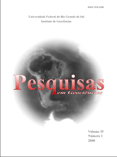Caracterização paleohidrológica de estruturas sedimentares quaternárias através de análises macroscópias e microscópicas: do registro sedimentar local aos indícios de mudanças globais
DOI:
https://doi.org/10.22456/1807-9806.20293Palavras-chave:
sedimentary structures, paleosoils, global changes.Resumo
Preliminary results based on macroscopic and microscopic analysis of quaternary sedimentary structures and paleosoils preserved on footslope deposits are presented in this paper. Together with geochronologic estimates for the main pedo-stratigraphic units, the paper suggests an evolutionary pattern for geomorphic surfaces situated at the highlands of the States of Paraná and Santa Catarina, Southern Brazil. the association of that pattern with global environmental changes is postulated. Based on sedimentologic and geomorphologic evidences, paleohydrologic interpretations suggest the predominance of relative wet local climates at the end of the Pleistocene. Indeed, 14C ages of paleosoils in the study area suggest the development of organic and hydromorphic soils during the coldest periods of isotopic stages 3 and 2. As peat horizons need anaerobic conditions to fully develop, such a result lead us to challenge the predominant role attributed to lower precipitation as a cause of geomorphic and vegetation changes during the Quaternary in the tropics and subtropics. Indeed, together with lower precipitation. Lower temperatures and, most important, an excess of precipitation over evaporation should be considered as the same importance. In so far, the indication of waterlogged soils, even during the Last Glacial Maximum, well explain the pattern of evolution of geomorphic surfaces and related pedo-stratigraphic features in the area. Indeed, taking into account the calibrated isotopic curves from Antarctic ice cores for the last 40 ka, we conclude that soil development and colluvial building by diffuse processes prevailed during Stadials, while pulses of erosive incision punctuated Insterstadials.



